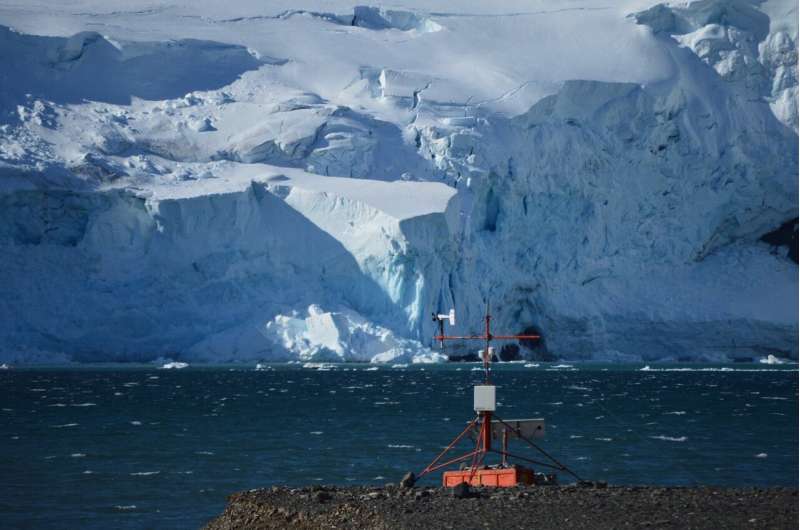Antarctic glacier retreats faster than any other in modern history, findings show

Sadie Harley
scientific editor

Robert Egan
associate editor

A glacier on Antarctica's Eastern Peninsula experienced the fastest retreat recorded in modern history—in just two months, nearly 50% of the glacier disintegrated.
A new CU Boulder-led study, in Nature Geoscience, details how and why Antarctica's Hektoria Glacier retreated at an unprecedented rate in 2023, losing a total of eight kilometers of ice in two months. The main driver was the glacier's underlying flat bedrock that enabled the glacier to go afloat after it substantially thinned, causing a rare calving process.
The new findings may help researchers identify other glaciers to monitor for rapid retreat in the future. Hektoria Glacier is small by Antarctic standards—only about 115 square miles, or roughly the size of Philadelphia—but a similar rapid retreat on larger Antarctic glaciers could have catastrophic implications for global sea level rise.
"When we flew over Hektoria in early 2024, I couldn't believe the vastness of the area that had collapsed," said Naomi Ochwat, lead author and CIRES postdoctoral researcher. "I had seen the fjord and notable mountain features in the satellite images, but being there in person filled me with astonishment at what had happened."
The research team, which included CIRES Senior Research Scientist Ted Scambos, surveyed the area surrounding Hektoria Glacier using satellites and remote sensing for a separate research study. They wanted to understand why sea ice broke away from a glacier a decade after an ice shelf collapse in 2002.
While analyzing results for the first study, Ochwat noticed data that indicated Hektoria had all but disappeared over a two-month period.
So, she set out to understand: why did this glacier retreat so fast?
Many glaciers in Antarctica are tidewater glaciers—glaciers that rest on the seabed and end with their ice front in the ocean and calve icebergs. The topography beneath these glaciers is often varied; they may sit upon deep canyons, underground mountains, or big flat plains. In Hektoria's case, the glacier rested on top of an ice plain, a flat area of bedrock below sea level.
Researchers previously found that 15,000–19,000 years ago, Antarctic glaciers with ice plains retreated hundreds of meters per day, and this helped the team better understand Hektoria's rapid retreat.
When tidewater glaciers meet the ocean, they can go afloat, where they float on the ocean's surface rather than resting on solid ground. The point at which a glacier goes afloat is called the grounding line. Using several types of satellite data, the researchers discovered Hektoria had multiple grounding lines, which can indicate a glacier with ice plain topography underneath.
Hektoria's ice plain caused a large part of the glacier to go afloat suddenly, causing it to calve quickly. Going afloat exposed it to ocean forces that opened up crevasses from the bottom of the glacier, eventually meeting crevasses exposed from the top, causing the entire glacier to calve and break away.
The team used satellite data to study the glacier at different time intervals and created a robust picture of the glacier, its topography, and its retreat.
"If we only had one image every three months, we might not be able to tell you that the glacier lost two and a half kilometers in two days," Ochwat said. "Combining these different satellites, we can fill in time gaps and confirm how quickly the glacier lost ice."
The researchers also used seismic instruments to identify a series of glacier earthquakes at Hektoria that occurred simultaneously with the rapid retreat period. The earthquakes confirmed the glacier was grounded on bedrock rather than floating, proving both the presence of an ice plain topography and that the ice loss contributed directly to global sea level rise.
Ice plain topographies have been detected across numerous glaciers in Antarctica, and the research on Hektoria will help scientists anticipate and forecast potential rapid retreat across the continent.
"Hektoria's retreat is a bit of a shock—this kind of lighting-fast retreat really changes what's possible for other, larger glaciers on the continent," Scambos said. "If the same conditions set up in some of the other areas, it could greatly speed up sea level rise from the continent."
More information: Naomi Ochwat, Record grounded glacier retreat caused by an ice plain calving process, Nature Geoscience (2025). .
Journal information: Nature Geoscience
Provided by University of Colorado at Boulder



















